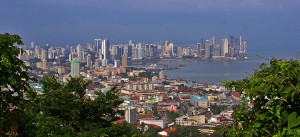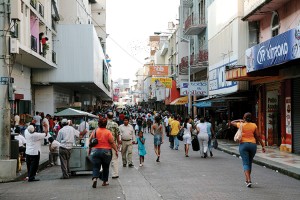Panama City 500
Wednesday, August 14th, 2019August 14, 2019
Tomorrow, August 15, is the 500th anniversary of the founding of Panama City, the capital and largest city of the Central American country of Panama. The city, which lies at the Pacific Ocean end of the Panama Canal, is the oldest European settlement on the Pacific coast of the Americas. Panama City has been a crossroads of world trade and travel since its founding in 1519, and it has grown into a modern international banking, cultural, and tourist center.

Panama City was founded 500 years ago, on Aug. 15, 1519. The city overlooks the Bay of Panama, part of the Pacific Ocean. Credit: © AFP/Getty Images
Panama City’s 500th birthday celebrations, titled Panamá 500, began in May with an urban art project known as the Panama Mural Fest. The project decorated the walls of each of the city’s 26 districts with paintings depicting the area’s diverse culture and history. In July and August, retrospectives on Panamanian cinema and photography took place, along with a variety of academic, cultural, dance, gastronomic, and musical activities. Tomorrow, August 15, the birthday party peaks with a boisterous parade and an elaborate fireworks show.

People stroll the Avenida Central in Panama City. The city is celebrating its 500th birthday in 2019. Credit: © JJM Stock Photography/Panama/Alamy Images
Pedrarías Dávila, a Spanish adventurer also called Pedro Arias de Ávila, founded Panama City in 1519, just six years after Vasco Núñez de Balboa became the first European to see the Pacific coast of the New World in 1513. At the time, Pedrarías was governor of an area that included parts of present day Panama. (A feud between Balboa and Pedrarías resulted in Balboa’s execution in 1519.) The newly constructed port, which became Panama’s capital in 1524, served ships that were exploring and exploiting the Pacific coasts of present day Ecuador, Peru, and Chile.

Click to view larger image
Panama City is home to a number of cultural attractions, including the Museum of Religious Art and the Museum of Contemporary Art. Credit: WORLD BOOK map
In 1671, the English pirate Henry Morgan led a force of 1,400 men against Panama City, and much of it was destroyed. (The ruins of the original city, known as Panamá Viejo [Old Panama], are a popular tourist attraction.) In 1673, Panama City was rebuilt about 5 miles (8 kilometers) away, and buildings from this time remain in the city’s Casco Viejo (Old Quarter). Casco Viejo was named a World Heritage Site in 1997, and Panamá Viejo was added in 2003. Such sites are places of unique cultural or natural importance, as designated by the United Nations Educational, Scientific and Cultural Organization (UNESCO).
Panama City prospered as Panama was increasingly used as a shortcut between the Atlantic and Pacific oceans (an alternative to traveling by ship around the tip of South America). In the mid-1800′s, a railroad was built across Panama to carry the many people traveling west during the California gold rush. Construction of the Panama Canal, which followed the railway route and opened in 1914, gave Panama City increased importance and made it a center for world trade.
Today, treelined boulevards cross downtown Panama City. This area contains a broad promenade along the seafront. Interesting downtown buildings include the Palace of Justice, the Presidential Palace, and the historic Museo del Canal (Canal Museum). The nearby ATLAPA (Atlantic and Pacific) Convention Center, which can hold more than 10,000 people, overlooks the ocean. The Panama Metro, Central America’s first urban rail system, opened in Panama City in 2014. The Biomuseo, designed by the American architect Frank Gehry, has exhibits about the history of the Isthmus of Panama and the region’s influence on world biodiversity. Outside the city, national parks protect the tropical rain forests, which are home to a wide variety of plants and animals.


